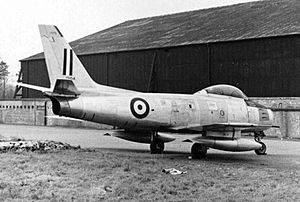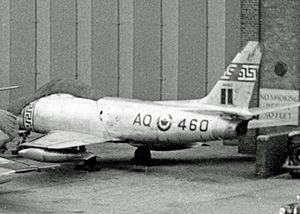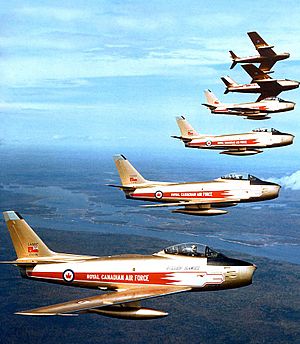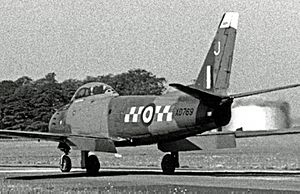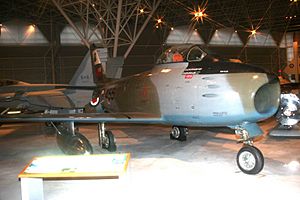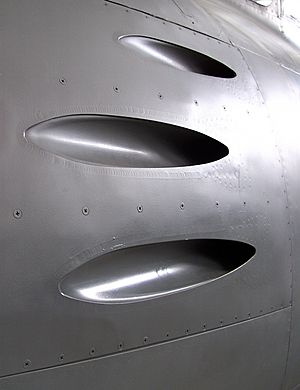Canadair Sabre facts for kids
Quick facts for kids CL-13 Sabre |
|
|---|---|
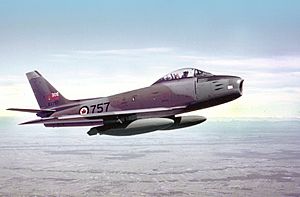 |
|
| An RCAF Canadair Sabre. Camouflage colouring was used on Europe-based aircraft. | |
| Role | Fighter |
| National origin | Canada |
| Manufacturer | Canadair |
| First flight | 9 August 1950 |
| Introduction | 1950 |
| Retired | 1980, Pakistan |
| Primary users | Royal Canadian Air Force United States Air Force Royal Air Force German Air Force |
| Produced | 1950–1958 |
| Number built | 1,815 |
| Developed from | North American F-86 Sabre |
The Canadair Sabre was a fast jet fighter aircraft. It was built by a Canadian company called Canadair. They made it under a special agreement with North American Aviation, which designed the original F-86 Sabre.
The Canadair Sabre was a version of the famous North American F-86 Sabre. It was made until 1958. The main user was the Royal Canadian Air Force (RCAF). They used it until 1962, when a newer plane, the Canadair CF-104, took its place. Many other countries' air forces also flew this aircraft.
Canadair built the Sabre in two main groups. The first group, called Mk. 2 and Mk. 4, were very similar to the American F-86. The second group, Mk. 5 and Mk. 6, were based on later American versions. These had bigger wings for better flying and used a more powerful Canadian-made engine called the Avro Canada Orenda.
The last Canadair Sabres used in active duty were in Pakistan. Their Mk. 6 models, which had AIM-9 Sidewinder missiles, were very important during the Indo-Pakistani War of 1971. These planes were slowly taken out of service after 1971. The very last ones stopped flying in combat in 1980. Even though newer, faster planes replaced them in most air forces by the 1960s, some later models were used for other jobs into the 1970s.
Some Sabres with the Orenda engine became famous for special achievements. One was the single Mk. 3, which was used to test the Orenda engine. In 1953, a pilot named Jacqueline Cochran used it to set several speed records. She became the first woman to fly faster than the sound barrier. Another Mk. 6, which used to belong to the RCAF, became a chase plane for Boeing's test flights until 1991. Many of these planes are now kept in museums.
Contents
Building the Canadair Sabre
In 1948, the Canadian government decided to get new planes for the RCAF. They chose the North American F-86 Sabre. Canadair was hired to build these planes in Montreal, Quebec, Canada. At first, they ordered 10 planes to check their tools and methods. But when the Korean War started, this order quickly grew to 100 aircraft.
Canadair slowly built up its factory to make almost all the parts for the Sabre. Other Canadian companies supplied the rest. Canadair called their Sabre project the CL-13.
Canadair made six different versions of the CL-13 Sabre:
- Sabre Mk.1: Only one was built. It was like the American F-86A.
- Sabre Mk.2: 350 were built. These had power-assisted controls and an "all-flying" tail.
- Sabre Mk.3: Only one was built. This was the first Canadian Sabre to use the powerful Avro Canada Orenda engine.
- Sabre Mk.4: 438 were built. These planes went to the RAF in the UK and then to other countries.
- Sabre Mk.5: 370 were built. These had the Orenda 10 engine and improved wings for better flying.
- Sabre Mk.6: 655 were built. This was the final version and was considered the best. It had an even more powerful Orenda 14 engine.
The very last Sabre made by Canadair (number 1815) was given by the Pakistan Air Force. It is now in the Western Canada Aviation Museum in Winnipeg, Manitoba. From 1950 to 1958, Canadair built a total of 1,815 CL-13 Sabres.
Sabre in Action
The Mk.2 was the first Canadair Sabre built in large numbers. From 1952 to 1953, 350 of these planes were made. The RCAF received 290 of them. The other 60 Mk.2s went to the U.S. Air Force for use in the Korean War. Most RCAF Mk.2 Sabres were used for air defense in Europe with NATO's No. 1 Air Division. They were excellent in air battles. Others were used for training in Canada. After 1954, many Mk.2s were updated and sent to the Greek Air Force and Turkish Air Forces.
The Sabre Mk.4 started production in mid-1952. It was very similar to the Mk.2, with only small changes. Out of 438 Mk.4s built, about 70 were used by the RCAF for a short time. All of these later went to the RAF. The rest of the Mk.4s went straight to the RAF. They were used by 11 RAF squadrons, mostly in West Germany with NATO. The RAF used the Sabre Mk.4 until 1956, when they were replaced by Hawker Hunters. Many of these planes were then given to other NATO countries, like Italy and Yugoslavia.
On July 30, 1953, the first Sabre Mk.5 flew. It had the Orenda 10 engine, which made it climb faster and fly higher. The Mk.5 also had a new oxygen system and improved handling. Its wings were made slightly larger, which helped it fly better, especially at lower speeds. Canadair built 370 Mk.5s. Most went to the RCAF squadrons in Europe. In 1957, 75 RCAF Sabre 5s were given to the German Luftwaffe.
The Canadair Sabre Mk.6 was the last version and was thought to be the best Sabre ever made. It had a very powerful Orenda engine. Its ability to fly high and climb fast was much better than the Mk.5. It also had special wing parts that helped it fly well at low speeds. The first Mk.6 was finished on November 2, 1954. In total, 655 were built, with production ending on October 9, 1958.
The RCAF received 390 Mk.6s. Most of these replaced the older Mk.5s in Europe. In the 1950s, the main air threats in Europe were Soviet planes like the MiG-15 and MiG-17. The Mk.6 Sabre was chosen because it was very effective against these planes, based on experiences from the Korean War. Canada promised NATO 12 squadrons of planes. These were at four bases: two in France and two in West Germany. At first, only Sabres were used, but later, Avro Canada CF-100 planes were added for night and all-weather fighting.
While most RCAF Sabres were in Europe, some were used by part-time units in Canada. Squadrons near Toronto, Montreal, and Vancouver flew Sabre 5s.
Besides the RCAF, 225 Canadair Mk.6 Sabres were sent to the West German Luftwaffe. Six went to the Colombian Air Force, and 34 went to the South African Air Force.
In 1966, Germany sold 90 of its Canadian Mk.6 Sabres to Iran. These planes were quickly sent to Pakistan. They became the main fighter planes for the Pakistan Air Force.
Canadair Sabres were very important in two major conflicts. In the Korean War, F-86 Sabres had a great record against enemy planes. In the Indo-Pakistani War of 1971, the Sabre was a main plane. Its opponent was the smaller Folland Gnat. The Gnat was called a "Sabre Slayer" by the Indian Air Force because it often won against the larger, older Sabres. Even though the Canadair Sabre Mk.6 was a great fighter, the Gnat could fly better in certain ways. Also, the Gnat was small and hard to see, especially when flying low.
Women's Speed Records
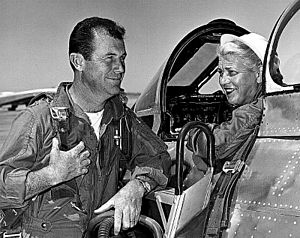
In 1952, Jacqueline Cochran, a famous pilot, wanted to break the world speed record for women. She tried to get an F-86 from the U.S. Air Force but was not allowed. Then, she met a Canadian Air Vice-Marshal. With permission from the Canadian Minister of Defence, she was allowed to borrow 19200, the only Sabre 3. Canadair sent a team of 16 people to California to help her.
On May 18, 1953, Ms. Cochran set a new speed record of 1,050.15 kilometers per hour (652.53 mph) over 100 kilometers. Later, on June 3, she set another record of 1,078 kilometers per hour (669.8 mph) over a 15-kilometer course. While in California, she also flew faster than 1,270 kilometers per hour (789 mph) in a dive. This made her the first woman to fly faster than the speed of sound!
Golden Hawks Flying Team
The Golden Hawks were a Canadian aerobatic flying team. They were formed in 1959 to celebrate two special events. It was the 35th anniversary of the Royal Canadian Air Force. It was also the 50th anniversary of Canadian flight, which started with the AEA Silver Dart in 1909.
At first, the team had six planes. They flew brightly painted metallic-gold Canadair Sabre Mk.5s. The plan was for them to perform for only one year. But the Golden Hawks became so popular after their first season (with 63 shows) that the team was made bigger. The next year, another plane was added. This allowed for a main formation of five planes with two solo jets. The Golden Hawks kept performing for three more seasons. They switched to the Mk.6 in 1961. The team was stopped on February 7, 1964. By then, they had flown a total of 317 shows all across North America.
Different Versions of the Sabre
- Sabre Mk.1: Only one was built. It was a test version like the F-86A.
- Sabre Mk.2: 350 were built. 60 went to the USAF, 3 to the RAF, and 287 to the RCAF.
- Sabre Mk.3: Only one was built in Canada. It was used to test the Orenda 3 jet engine.
- Sabre Mk.4: 438 were built. 10 went to the RCAF, and 428 went to the RAF as the Sabre F 4.
- Sabre Mk.5: 370 were built. These had the Orenda engine. All went to the RCAF, and 75 were later given to the German Air Force.
- Sabre Mk.6: 655 were built. 390 went to the RCAF, 225 to the Luftwaffe, 6 to Colombia, and 34 to South Africa.
Who Flew the Sabre?
Many countries used the Canadair Sabre:
 Bangladesh
Bangladesh Canada
Canada
- Royal Canadian Air Force (RCAF)
 Colombia
Colombia
- Colombian Air Force
 West Germany
West Germany
- German Air Force (Luftwaffe) - They used 75 Mk.5s and 225 Mk.6s from 1957 to 1964.
 Greece
Greece
- Royal Hellenic Air Force - They used 120 Mk.4s from the RCAF.
 Honduras
Honduras
- Honduran Air Force - They got 10 Sabres from Yugoslavia in 1976.
 Italy
Italy
- Italian Air Force - They used 179 Mk.4s from the RAF from 1956 to 1976.
 Pakistan
Pakistan
- Pakistan Air Force - They used 90 Mk.6s from 1966 to 1980.
 Union of South Africa
Union of South Africa
 Turkey
Turkey
- Turkish Air Force - They got 107 Mk.2s from the RCAF in 1954.
 United Kingdom
United Kingdom
- Royal Air Force (RAF) - They used 3 Mk.2s and 428 Mk.4s.
 United States
United States
- United States Air Force (USAF)
 Yugoslavia
Yugoslavia
- JRV Yugoslav Air Force - They received 121 Mk.4s from the RAF.
Sabre Specifications (Mk.6)

Here are some facts about the Sabre Mk.6:
- Crew: One pilot.
- Length: About 11.4 meters (37.5 feet).
- Wingspan: About 11.3 meters (37.1 feet).
- Height: About 4.5 meters (14.7 feet).
- Empty Weight: Around 4,825 kilograms (10,638 pounds).
- Max Takeoff Weight: Up to 7,974 kilograms (17,580 pounds).
- Engine: One Avro Canada Orenda 14 turbojet engine.
- Top Speed: 1,122 kilometers per hour (697 mph) at sea level.
- Stall Speed: 178 kilometers per hour (111 mph) at sea level.
- Range: 2,383 kilometers (1,481 miles) with extra fuel tanks.
- Ceiling: Can fly up to 16,489 meters (54,100 feet).
- Climb Rate: Can climb 61 meters (200 feet) per second.
- Guns: Six .50 caliber M3 Browning machine guns.
- Weapons: Could carry rockets (like 18 SNEB 68mm rockets or 16 HVAR 5-inch rockets). It could also carry two infrared AIM-9B Sidewinder missiles (Mk.6 only).
- Bombs: Could carry up to 2,400 kilograms (5,300 pounds) of bombs. This included two 1,000-pound bombs plus two extra fuel tanks. It could even carry a small tactical nuclear weapon.
Images for kids
- 1972 Sacramento Canadair Sabre accident
- Aircraft related to this one
- CAC Sabre
- North American FJ-1 Fury
- North American F-86 Sabre
- North American F-86D Sabre
- North American FJ-2/-3 Fury
- Similar aircraft
- Dassault Mystère
- Mikoyan-Gurevich MiG-15
- Lists related to this aircraft
- List of fighter aircraft
See also
 In Spanish: Canadair CL-13 Sabre para niños
In Spanish: Canadair CL-13 Sabre para niños



